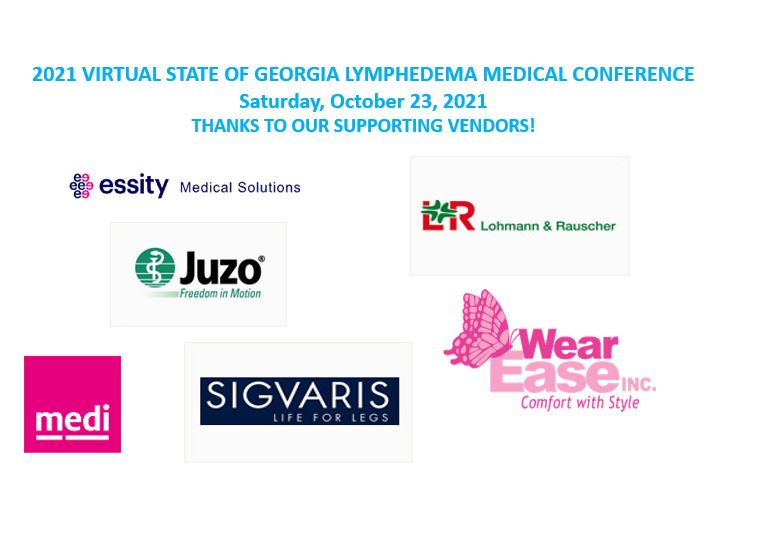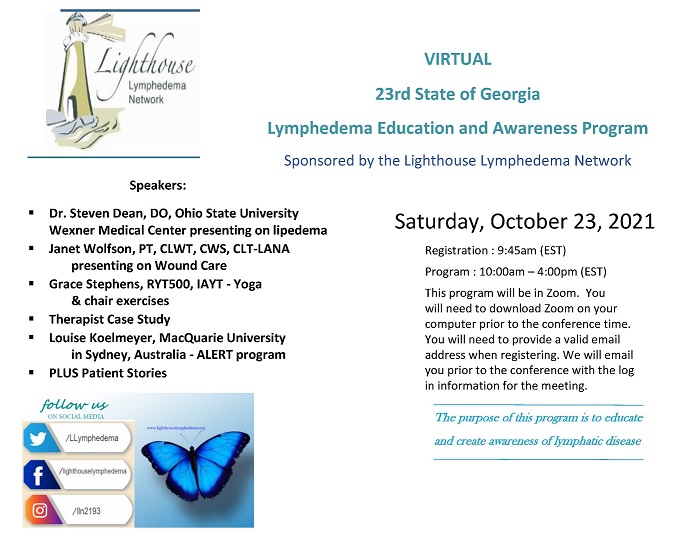
The 23rd Annual Lighthouse Lymphedema Network conference was held by Zoom on October 23, 2021. Despite the challenges of pandemic and technology, all presentations were high quality and informative, and attendees came from different states and countries via computer.
Technical glitches may have prevented some attendees from entering the webinar, and we apologize for any frustrations. Our tech wizard from 2020, Nadine King was taken by the virus, and other board members have stepped in to learn her roles. Many thanks to Elaine Gunter, Bret Martin and Billie Barron for all their work organizing and hosting the Zoom seminar. We hope that reviews of our speakers will educate and inspire readers to look online for additional articles and video presentations.
SPEAKERS
What is Lipedema?
STEVEN DEAN, DO, Director of the Vascular Medicine Program and Noninvasive Peripheral Vascular Laboratory at The Oh io State University Wexner Medical Center where he also serves as a professor of clinical medicine. Dr. Dean is one of “America’s Best Doctors.”
io State University Wexner Medical Center where he also serves as a professor of clinical medicine. Dr. Dean is one of “America’s Best Doctors.”
Lipedema is unhealthy tissue. It is frequently misdiagnosed as lymphedema or obesity, but specific characteristics differentiate lipedema and lymphedema. Lipedema is bilateral, symmetrical, and typically spares the hands and feet. Lymphedema can be unilateral and asymmetrical, and often affects the hands, feet, or toes. Lipedema usually affects women and has strong genetic and hormonal influences. Lipedema tissue cannot be removed through diet and exercise, though both help reduce obesity and inflammation associated with lipedema.
Three stages of lipedema progression are listed as Stage I, marked by smooth tissue and skin with increased fullness; Stage II, marked by formation of nodular tissue (mattress pad appearance); and Stage III, marked by development of lobes, in particular the dewlap at the thighs. Not all individuals with lipedema will progress through all stages.
Six different phenotypes of lipedema can be identified. Type I involves the hips and buttocks. Type II involves the hips to the knee. Type III involves hip to ankles. Type IV is identified in the arm, and Type V is distal legs. Often, Type I presents with Type IV proximal arms.
Eighty percent of lipedema patients present with hypermobility. Therefore, a thorough clinical assessment should include the Beighton score. The hypermobility occurs due to joint laxity caused by the connective tissue disorder. Cutaneous hypothermia is also common in lipedema.
A new Standard of Care for Lipedema in the United States (Herbst et al, 2021) was recently published to share current recommendations and treatment. This document already has more than 200,000 downloads.
Lipedema Patient Story and Therapist Treatment
SAMANTHA CANNON MARTIN, MSOT, CLT, formerly Northside Hospital Forsyth, now in private practice.
Patient: FRANCINE SCHWARTZ SCHULER
___________________________________________________________________________________
Francine has both lymphedema and lipedema. She is an activist for the Fat Disorders Resource Society.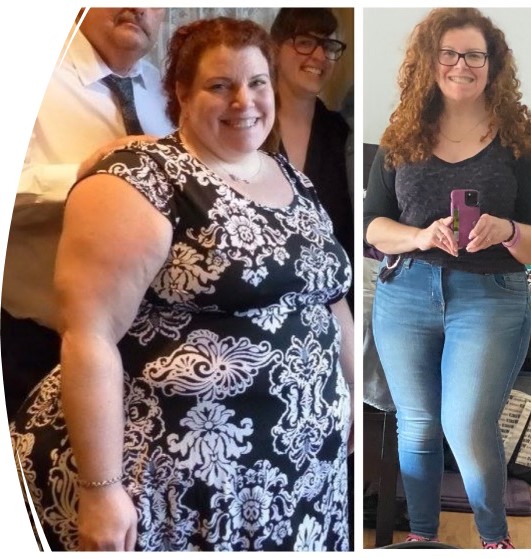
___________________________________________________________________________________
All my life I have been fighting my weight problem. Unbeknownst to me I had a hereditary and hormonal disease called Lipedema, which manifested in my body from my waist to knees.
Last year I was diagnosed as Stage 3/4 Lipolymphedema, which is a combination of Lipedema and Lymphedema, and I was rapidly becoming immobile. Since then, I’ve studied ways to stop the progression of these diseased fat cells, had surgeries to remove existing “super fat,” worked with a nutritionist (the diseased fat thrives on sugar and carbs), and worked with my occupational therapist to develop and follow a lymphedema protocol.
Lipedema fat is not reactive to diet and exercise, so that is why I was always “Bottom-heavy” despite strict dieting and exercise. I’m so grateful to finally know why efforts would fail and that I was fighting an unknown disease.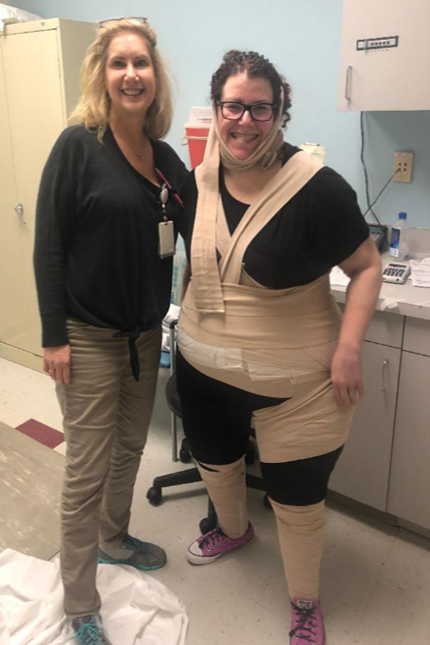
The lymphedema therapist is an essential member of the lipedema treatment team. Samantha helped with diagnosis of Francine’s lipedema by taking measurements and noting the differences in tissue while performing manual lymphatic drainage prior to and after the surgical interventions. She also addressed joint issues, updated wrapping, found appropriately fitted compression garments and footwear to reduce lymphedema and helped Francine’s body adjust to the changes created by lymph-sparing waterjet-assisted liposuction surgery. Care of the sensitive skin is important in lipedema treatment. A heart monitor is needed with exercise therapy.
Lipedema Case Study
KIM KENNEDY, MSOT, OTR/L, CLT-LANA
Penrose St. Francis Outpatient Rehab Centura, Colorado Springs, CO
Kim has developed programs in Cancer Rehabilitation, lymphedema, and CVA constraint therapy. She currently specializes in lipedema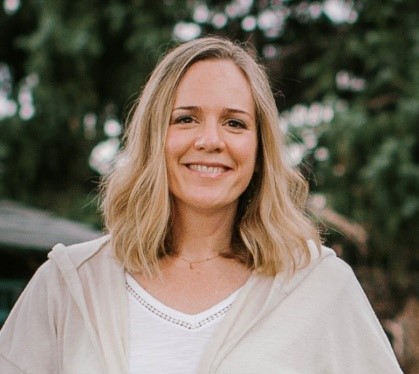 therapy.
therapy.
Kim’s medically complex and socio-economically challenged patient did not receive lymphedema or lipedema diagnosis or therapy while hospitalized. Kim evaluated and worked with the patient to achieve some improvement with MLD therapy and compression garments. The pandemic interrupted therapy, as it did for many patients. Kim is working to raise awareness of lymphedema and lipedema among medical professionals, so early education and proactive treatment can become the norm.
For more information, read: “Lipedema and Obesity, What’s the Link,” by Karen Herbst, PhD, MD, 2014 at www.obesityaction.org
Wound Care in Lymphedema Therapy
JANET WOLFSON, PT, CLWT, CWS, CLT-LANA
Wound Care Coordinator, Encompass Health, Ocala, FL
Janet is a former board member of the Lighthouse Lymphedema Network, and an instructor in wound care with the International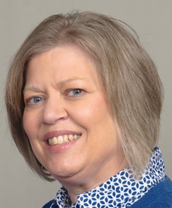 Lymphedema and Wound Training Institute as well as a lymphedema therapist. The lymphedema patient with an impaired immune system is more susceptible to infection and developing wounds.
Lymphedema and Wound Training Institute as well as a lymphedema therapist. The lymphedema patient with an impaired immune system is more susceptible to infection and developing wounds.
She reviewed products that promote healing of wounds during therapy, including Antimicrobial Hydro Fiber, Aqua Conductive Technology, and Polyurethane Foam. Patients with lypodermatosclerosis may develop wounds with heavy drainage and maceration and will benefit from these products for wound healing.
A wound with high exudating levels may need NPWT deep wound negative pressure therapy. The patient should be treated for infection before donning vac and this product can be worn under compression wraps, but secure tubing with foam to protect the skin. Short stretch or Velcro wraps may be used for compression.
How to Find a Qualified Lymphedema Therapist
JUDITH NUDELMAN, M.D., is a Clinical Associate Professor with the Department of Family Medicine, Alpert Medical School, Brown University; She is a certified lymphedema therapist and a member of the board of directors for the Lymphology Association of North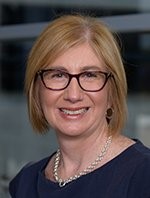 America and the American Lymphedemas Framework Project.
America and the American Lymphedemas Framework Project.
Dr. Nudelman has experienced lymphedema treatment as a patient, as a doctor referring patients, and as a certified lymphedema therapist working with patients after cancer treatment. She reviewed the historic lack of understanding and treatment options for this condition. While the Women’s Healthcare Act of 1998 guaranteed insurance coverage for treatment of breast cancer-related lymphedema, coverage is often denied for other types. Only physical and occupational therapists are covered by insurance for lymphedema treatment, though some doctors and massage therapists are becoming certified for lymphedema therapy.
Lymphedema Therapists need supervised experience as well as 135 hours of training before becoming certified.
They provide diagnosis, manual treatment, bandaging, fitting of compression garments, therapeutic exercises, instructions for use of pneumatic pumps, education about lymphedema and self-care, and emotional support. Therapists can be found through medical practices, and websites like www.lighthouselymphedema.org Understanding of and treatments for lymphedema are improving, so patients should persist in studying this condition and pursuing treatment.
The ALERT Program – Diagnosis and Treatment of Lymphedema in Australia
LOUISE KOELMEYER, BAS in OT, PhD, MS
Director of Australia Lymphoedema Education, Research and Treatment (ALERT) Program and Senior Lecturer at Macquarie University, Sydney, Australia.
Education, Research and Treatment are three arms of the ALERT program, which features a multidisciplinary team. Specialists in rehabilitation, radiation oncology, plastic surgery, interventional radiology, education, and research work together to find and provide the best possible care for patients, and train new therapists to treat lymphedema using Indocyanine Green (ICG) mapping.
At the ALERT multidisciplinary clinic, Louise is involved in the pre- and post-operative rehabilitation of patients following liposuction surgery. She also assists in collecting and reporting data based on ICG imaging of various lymphedema populations.
Data collected through ALERT may change the way therapists perform manual lymphatic drainage (MLD). Contrary to current methodology, the findings from ICG imaging demonstrate that in breast cancer-related lymphedema (BCRL), zero percent of individuals drain within the substitution pathway from the axilla to the ipsilateral inguinal nodes. Also, leg lymphedema patients often drain to the ipsilateral inguinal nodes rather than the contralateral inguinal nodes.
The use of ICG can determine lymph stasis in the dermis or the lymphatic vessels. The ability to visually locate lymph stasis is a medical break-through as these images help determine the speed and pressure necessary for effective MLD. Lymph stasis in lymph vessels requires gentle and faster massage, whereas firm and slow massage is required for dermal backflow. In the United States, ICG Lymphography is being used in conjunction with lymphedema microsurgery, but the idea of expanding its use for support of lymphedema therapy and MLD is new.
Yoga – Seated or Standing
GRACE STEPHEN, E-RYT500, IAYT
Professional Yoga Therapist, Qigong & Tai Chi instructor, Doctor of Chiropractic, Somatic Exercise Coach, Kennesaw, GA
Specialties: Yoga for Athletes, Adaptive Yoga for Disabilities
Grace’s healing energy came through the computer as she led us through exercises to relax and center the body and mind. She demonstrated cupping, pumping, spinal core breathing, sweeping action to stimulate the lymphatic system, and poses including cat/cow and monkey paws. Every yoga session ends with a rest session with legs propped above the heart if possible. Rest helps one absorb the stretches and remember to transition from one activity to the next.

